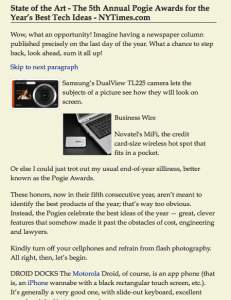We all know this year’s Superbowl commercials displayed a less-than-shocking theme of masculinity under attack by women/harpies–and men’s resulting desperate need to bolster it through muscle cars and micro-televisions:
Does anyone else find it kind of heartening that even the ad-men think that such versions of gender roles are making their “last stand” — and acknowledging implicitly that they’ll fall like General Custer? (Of course, they’re probably relying on another problematic subtext: it’s just a battle lost, not the war. Though that might be giving them too much credit for self-consciousness.)
It’s been great fun to have the rampant sexism in advertising called out in the mainstream media (Slate, the Times, even USA Today— especially in light of studies suggesting how unsuccessful these ads were. And I’m ready to enjoy the potential for wittier and far cheaper responses:
I dig certain parts of this: “I will make $.75 for every dollar you make doing the same job…I will catch you staring at my breasts but pretend not to notice…” In some ways, I can see that it’s pointing out how the assumptions behind these duties are equally ridiculous. Those accepted by the men in the Dodge commercial are, for the most part, basic measures of maturity (“I will shave… I will be at work… I will sit through meetings”) undertaken not as a man but as reluctant partner (“I will take your calls”?!). But the spoof’s duties suggest that what women do for the sake of their men is not about basic hygiene, but self-subjugation: “I will diet, Botox, and wax–everything… I will allow you to cheat on me with younger women”?! Hmmm. If this spoof is looking to encourage identification among women, then depending on such assumed “duties” is disconcerting. And if it’s trying to challenge the sexism of the original, isn’t falling back on superficial standards counterproductive?
I’m not sure. I’m happy to see some talk-back to those ads, and can only hope we see more discussion as a result.
In the meantime, I leave you with SNL’s hilarious take on the powers of a Dodge to recuperate the male ego:






